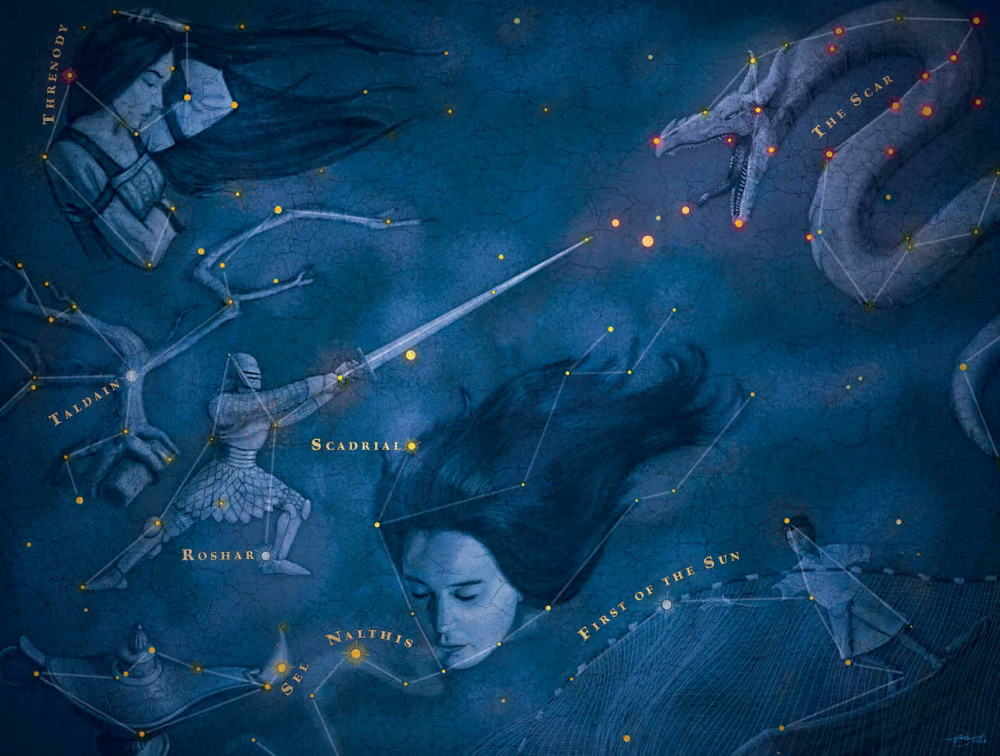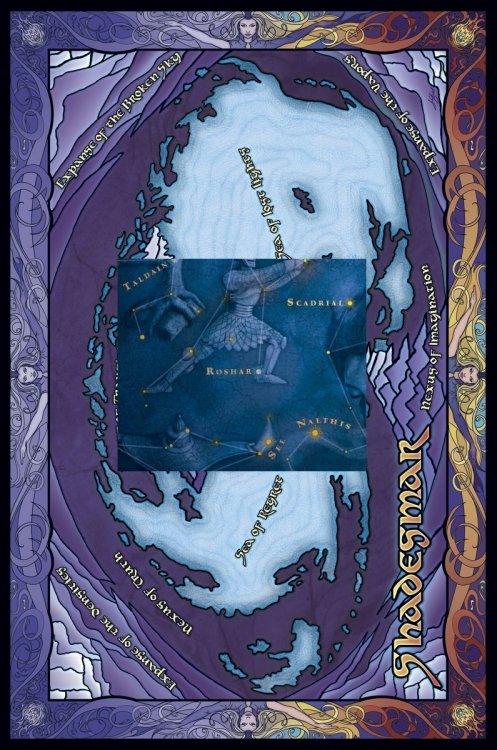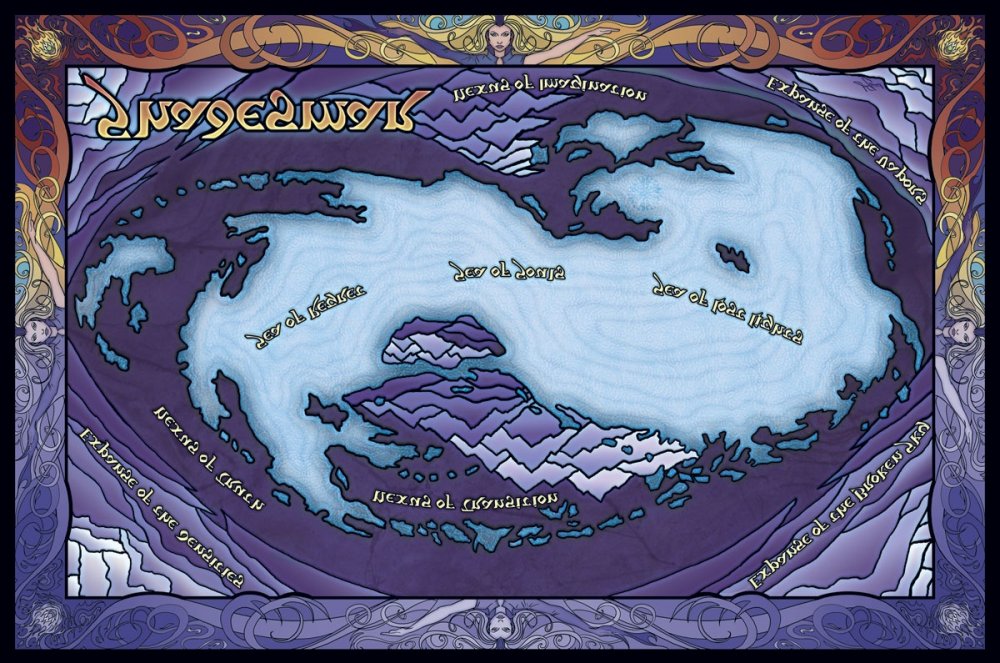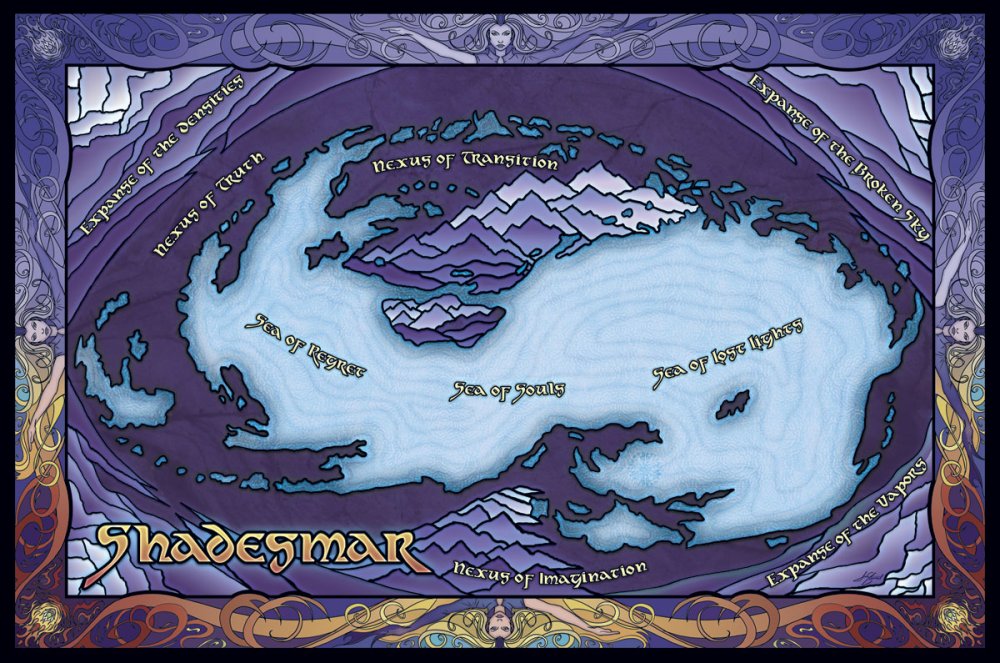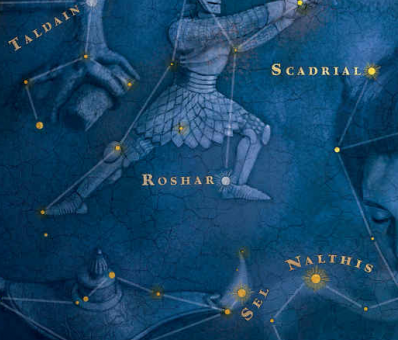-
Posts
324 -
Joined
-
Last visited
Content Type
Profiles
News
Forums
Blogs
Gallery
Events
Everything posted by KidWayne
-
A being with a heart full of hate who wants to do things her own way with no regard for anyone else's input or authority? Yeah, that sounds like a pretty decent template for a Devil / Satan character to me... +1
-
Well, "Expanse of the Vibrance" makes a lot of sense for Nalthis with its colors. On the other hand, "Expanse of the Densities" makes no sense at all for Sel so I'm not sure that it matters. However, that tidbit does make me favor the portrait orientation over the landscape orientation. So, we are all on board with this now, right? Taldain (Expanse of the Broken Sky) Scadrial (Expanse of the Vapors) Sel (Expanse of the Densities) Nalthis (Expanse of the Vibrance)
-
So if you look at the position of Roshar on the Cosmere map... you can kind of extrapolate where the "Expanses" on the Shadesmar map lead since we know that the Expanse of the Vapors leads to Scadrial. To do so you would need to imagine holding a copy of the Shadesmar map in front of you... and place it face down on top of the Cosmere map, rotating the top edge of the map towards your body. Now the Expanse of the Vapors is pointing towards Scadrial. Sort of like this... This means that the Expanse of the Broken Sky is Nalthis and the Expanse of the Densities is Sel. The remaining corner would point toward Taldain which is apparently closed, so it makes sense that an "Expanse of the ___" would not be listed for Taldain. However, you could also rotate the map this way and still have the Expanse of the Vapors pointing towards Scadrial: This would change the assignments to: Expanse of the Broken Sky → Taldain Expanse of the Densities → Sel Blank Corner → points toward Nalthis I favor the first (i.e. landscape) orientation because having the blank corner point to Taldain makes a lot of sense.
-

Nalan and the Kholin Issue [Edgedancer Spoilers]
KidWayne replied to Walker's topic in Stormlight Archive
Doesn't the fact that Adolin has a Ryshadium predispose him to obtain a Nahel bond? -
Here's a few ideas: Coinshot / Lurcher rides (zip lines, roller coasters, and/or "Tower of Terror" style ride) Lurcher obstacle course (ropes course with swinging vines) Lurcher swings Coin shot games Hazekiller arcade Ascension coaster (imitates bronze pulses and steel push jumps to Kredik Shaw, plunging into the Well of Ascension, then it gets all cosmic and ends in the edenic Elendel basin) Vin's Horseshoe trick spinner ride City wall bungee jump Pewter drag rush (drag racing style ride or some kind of robot/tech assisted running) Conventicle of Seran (haunted house) Pits of Hathsin coaster (or maze) Koloss Frenzy coaster House War laser tag Skimmer (Iron Ferring) bounce house or weightless simulation Steelrunner (Steel Ferring) coaster Gasper (Cadmium Ferring) Aquarium or scuba diving Skimmer (air ship in Wax & Wayne Era) coaster or transport Band of Mourning Temple rush (could be a roller coaster) Shadesmar corpse barge (log flume or other water ride) You could get a Nobelman's pass to skip to the front of the lines
- 30 replies
-
4
-
Sorry to double post. On a more serious note (and to actually contribute to this thread), my biggest question is who is being referred to as "their" here: "They" could be the Parshendi or the Alethi. If FiveLate is correct and "this one" refers to Taravangian, then "they" would presumably be the Alethi since he intends to conquer the world in order to unite humanity. It doesn't make a lot of sense for "they" to be the Parshendi because I'm unaware of how Taravangian would obtain their power. However, if "this one" refers to an individual Parshendi, then "they" would presumably be the Parshendi and this section of the Diagram is warning that the Alethi must be pushed to destroy the Parshendi before "this one" / "one of them" obtains their power. Another interesting thing here involves a conflict between classical grammar rules and contemporary usage of the term "their" as a singular possessive pronoun that can used for either gender (or when the gender of the person referred to by the pronoun is unknown or ambiguous). Classical grammar dictates that "their" is always a plural possessive pronoun and that the phrase "he or she" should be used when the gender of the person referred to by the pronoun is unknown or ambiguous. Either way it leaves us with a few possibilities; the Diagram is saying that... the Alethi should be pushed to destroy the Parshendi before this one special Parshendi obtains the power of his/her people, the Alethi should be pushed to destroy the Parshendi before this one special Parshendi obtains the power of the Alethi the Alethi should be pushed to destroy the Parshendi before Taravangian gains the power of the Parshendi, or the Alethi should be pushed to destroy the Parshendi before Taravangian gains the power of the Alethi. Finally, the Diagram appears to say that one of these things could result in the formation of a "bridge." This result appears to favor possibility #1 since Eshonai's transformation into Stormform resulted in the summoning of the Everstorm which appears to have enabled voidspren to enter Roshar en masse. So, it would be possible to view the Everstorm as a sort of bridge or portal which allows the return of the voidbringers. However, there's still a lot we don't know. This is simply the best interpretation based on the data we have so far and the actions of the Heralds give us reason to wonder about what the "bridge" is, how it is formed, how Desolations are connected to murdering proto-Radiants, how the return of Taln affects Desolations, how the summoning of the Everstorm makes this Desolation different from previous Desolations, and how the Everstorm allows voidspren to invade Roshar when Highstorms do not appear to have a similar effect on other spren (except for windspren).
-
Ok, it took me a minute to realize that the "Mr. T" referred to in the OP was not this guy: Then once I realized we were talking about Taravangian, I couldn't shake the above image of the A-Team character, but the fact that the King of Kharbranth is supposed to be elderly bothered me. So, I Googled "old Mr. T" and I found this: This is now my mental picture of Taravangian. Thanks @CaptainRyan.
-
So in Hoid's first meeting with Kaladin, he tells Kaladin a story about the Wandersail. This story led Kaladin to finally overcoming his depression/apathy and embracing his surge binding abilities. Note the underlined part (added for emphasis). I see a connection between the behavior of the Uvara and that of the Skybreakers / Nale who are murdering new surgebinders. I also see a connection between the Emperor of the Uvara and Honor/Tanavast (because he's dead and the people don't realize it) or perhaps Ishar (since Nale was justifying his actions on Ishar's assurances/warnings) . I was hoping that others might ... consider this connection and offer your thoughts/criticism, and think about whether any other events in Edgedancer connect to the Uvara (or other stories, legends, etc.) Thanks!
- 1 reply
-
4
-
- derethil
- wandersail
-
(and 2 more)
Tagged with:
-
I think you're on to something here. Remember that in Mistborn, someone had to go to the Well of Ascension and use the power. In order to free Ruin, the power had to be released instead of used. So if the Oathpact binds Odium and the voidspren similar to how Preservation bound Ruin, desolations are periodic episodes that result from the accumulation of Odium's investiture. However, in order to have an effect on Roshar, the Oathpact requires some sort of action be taken on the part of the Heralds (an attempt to escape torture perhaps?). This action releases Odium and the Heralds to act directly upon Roshar for a time. The Heralds are supposed to return to Roshar to defend it from Odium's onslaught. Once Odium is defeated, they are to return to their captivity to reset the ties that bind Odium. However, if they stay on Roshar for too long of a time, it fails to re-bind Odium and he remains free to attack Roshar once more. Presumably this cycle will continue until the Heralds abandon the Oathpact, or Odium slaughters everyone on Roshar (including the Heralds) before the Heralds' allotted time is up. This seems pretty consistent to me. NOTE: Sorry about the double post. These things just seemed way too different for the same post.
-
I think you're on to something with the making of an Honorblade. If spren are the manifestation of ideas and each of the Heralds embodies an ideal, then is it too far out to think that Honorblades are manufactured spren (or splinters of Honor) that were fashioned after honorable ideas and then invested to the hilt? This would make good sense for how and why the Heralds could "bind" surges. +1
-
@PallonianFire Yeah, but doesn't that still leave open the possibility that Autonomy is divesting himself from the Taldainian system's "Sun" and is trying to Invest Scadrial? Your idea is valid but it does nothing to suggest that Autonomy had to be invested on Taldain itself. Khriss getting off-world could be possible via a Taldainian magic system (e.g. Elsecallers on Roshar).
-
@ Blightsong Hmm, cool. Thanks for the update. I really didn't like the idea of there being a "devil" to antagonize Adonalsium, so this is good news in my opinion. I'm going to go back edit the last paragraph of my post now.
-
Oftentimes, your autonomy/freedom inhibits or decreases my autonomy/freedom. This is especially true in a world of limited resources. That is why we have laws that attempt to find the most equitable balance between prohibitions and rights. So, perhaps that is the source of autonomy's apparent contradictions?
-
Upon learning that Bavidin/Autonomy was the shard on Taldian, I went looking for him in the story. What I teased out was that the heroes of the story were the heroes because of their autonomous actions. Kenton defied the will of his father. His father was apparently blackmailing at least one of the other professions, and when made interim Lord Mastrell, Kenton undid that as well in an effort to save the Sand Masters. The former Lord Mastrell manipulated and dominated others whereas Kenton defied him through self-determination (achieving freedom and power in the process). I think the Sand Lord's alleged problem with the sand masters had to do with their abuse of their power; specifically, the way they used their power to manipulate and/or control others through intimidation. Khriss comes into her own once she lets go of the things holding her down: her obligations to the court and her fiancé. She gets even stronger as she comes to see the lies that keep people on darkside immobile and under the thumb of Scythe. Eric's story is a tragedy because he goes against his will (i.e. he surrenders his autonomy) because of his devotion to his friend. The bad guy in the epilogue is cast as a bad guy because he uses force to invalidate an election. So, in the context of the story, Bavadin is a good and benevolent god who supports the autonomy of his people. He uses his influence to maximize autonomy on his world and chooses to act through a handful of chosen people. This is entirely consistent with how we see Sazed behaving on Scadrial. It also works well with the 'Autonomy is Trell' theory as a way to explain Paalm's actions in SoS. The question it doesn't answer is what Bavadin and Rayse have in common. The only thing that makes sense is that all the 'good' shards are more or less aligned with Hoid who appears to have an agenda to reunite the shards. Autonomy would obviously oppose this, so perhaps Bavadin and Rayse have common ground in their desire to remain separate. This would also explain why they find Sazed to be a threat; he is the first to hold multiple shards since the Shattering. However, there's also Adonalsium's shadowy opposite out there somewhere (according to WoB). Autonomy is certainly a quality associated with atheism, and submission is often a quality associated with the faithful. I have no idea what Adonalsium's opposite would be like, because we don't know that much about Adonalsium. For all we know, Adonalsium was the bad guy. However, I suppose it is possible that Bavadin and Rayse may have allied with Adonalsium's opposite, which would obviously make them enemies of Hoid (assuming I'm correct in my theory about hoid's agenda to reunite the shards).
-

How are all these Worldhoppers Getting Around?
KidWayne replied to Magestar's topic in Cosmere Discussion
Take a look at this post/thread for more info on perpendicularities and sharpools. Relevant post/thread (sorry my browser at work won't let me post hyperlinks the easy way and I'm too lazy to look up the html for it): http://www.17thshard.com/forum/topic/47625-shardpool-question/?p=351997 -
@ EagleOfTheForestPath I love the nonchalant attitude with which you destroyed my little fantasy world there (seriously, no sarcasm involved). "Yeah... all of those are basically impossible" made me laugh. I know that you can't actually transplant souls with Forgery; you can only create replicas of them. What I question is what the limits are to the implausibility constraint. Obviously, Nightblood or a spren wouldn't think it was odd for a person to become a sword. So, how implausible is it really?
-
Journey before Destination, friend. I'd say no. Warning: Random subject change ...that may involve Batman On the other hand, isn't it kind of a major trope in any hero story that the hero - if he hangs around long enough - becomes the villain? Heroes tend to save the day by either (1) preventing events or actions that would up end the status quo or (2) rescuing innocent people from oppression/victimization. Heroes that accomplish #2 by overthrowing a tyrant soon find themselves in a position of authority or influence and they maintain that position by repetitively accomplishing #1. It takes a hero like Batman - who maintains anonymity and avoids directly wielding political/social power - to avoid this trap. (SIDE NOTE > I just realized that Hoid has both of those qualities and that he likes to operate "from the shadows" in a way not unlike Batman... hmm.) However, it can be argued that even Batman simply upholds the status quo of a capitalist plutocracy by enforcing laws made by politicians whose campaigns are primarily financed by contributions from the wealthy. He generally avoids being labeled this way though because he generally saves more people from being victimized than he protects the fortunes of the wealthy. Now that I've gotten that out of my system... My point is that it's hardly abnormal for Sanderson to take a hero revolutionary and slowly mold him into a villain, we probably should have seen it coming since Kelsier has the makings of an awesome bad guy.
-
Interesting (potential) way to get some basically non-existent atium, wouldn't you say? You're more or less suggesting soul stamps as the functional equivalent of alchemy in the Cosmere. It would certainly help bring down the cost (or at least increase the supply) of some rare metals if you could just soul stamp some pig iron to produce bendalloy, aluminum, etc. EDIT: You know what, this is already possible with soul casting. It's also probably easier to accomplish with soul casting since there's no danger of soul casted metal reverting to its previous form. However, we are consistently told that investiture interferes with investiture, so this probably wouldn't work. There is a possibility that it would though, since metals aren't actually invested; they're simply keys that unlock the innate investiture of the allomancer. So, the question becomes, "Are soul stamped objects invested? If so, would a soul stamped metal interfere with an allomancer's innate investiture?" I like the theory, there are a lot of interesting possibilities for this. My question would be how breath interacts with soul stamps. Could a skilled Forger create another Nightblood by stamping a soul onto a sword? Could you "free" Nightblood by soul stamping its soul onto a human? What would happen if you soul stamped a lifeless into the form of a sword? Can you stamp a soul (i.e. sentience) onto a lifeless (e.g. one of Kalad's Phantoms)? Can you stamp a soul onto an object as a short cut to creating a sentient object? These are fun things to consider.
-
I assume that since we have seen a "Regrowth" fabrial, it is possible to construct fabrials that imitate the powers of each of the 10 surges.
-
Man, I'm a little nervous about rejoining this conversation, but I feel like I have something substantive to add. Your first sentence there kind of helps illustrate a link between these two types of relationships that is relevant to the conversation about the necessity of experience. That link is culture. Here in the United States, it's not uncommon for broad racial groups to identify with a single culture or a relatively small set of cultures. Each of these culture groups may have a large number of subcultures, but there isn't a lot of variation in the broader culture groups. For this reason, it's common for interracial couples to experience a little bit more culture shock when their backgrounds clash than couples who come from the same race. The race element here is a shortcut. The exact same thing could happen when a Buddhist marries an Orthodox Jew, or when a world-travelling bloke from the UK gets involved with a never-been-off-the-ranch type of girl from Texas. A lot of these clashes don't happen in the context of a dating relationship, but when you start bringing your sweetheart home to mom and dad or when you begin to start a family a lot of couples discover that they (or their families) have unspoken expectations that may be mutually exclusive of their partner's preferences. It's not the skin-tone; it's the culture. I'd argue that each letter in the LGBT acronym represents a different sub-culture in a larger homosexual culture group. Furthermore, I'd argue that straight men are less likely to take an interest in the proclivities and inclinations of gay men than vice versa - simply because straight men enjoy the privilege of heteronormativity. Most straight men don't have to learn how to fit in with gay men, but almost all gay men have to learn how to fit into a heteronormative society. So, when an author needs either experience or interest to guide him in penning a novel, a typical straight male author will be hard pressed to convincingly write a story about a gay character.
- 63 replies
-
1
-
- preservation
- riun
-
(and 2 more)
Tagged with:
-

How are all these Worldhoppers Getting Around?
KidWayne replied to Magestar's topic in Cosmere Discussion
World-hoppers are basically travelling through Shadesmar (a.k.a. the Cognitive Realm). Each major "Shardworld" has one or more ways of entering Shadesmar through either magic or a "shardpool" which is a location in the Physical Realm where a shard's investiture collects. Someone who knows what they are doing can use a shardpool (a.k.a. perpendicularity) to physically enter the Cognitive Realm. Since empty space that is devoid of thinking creatures is compressed in the Cognitive Realm, a world-hopper physically travelling through the Cognitive Realm can travel across solar systems in a matter of days (or maybe weeks, we don't have solid answers on the speed at which one can traverse distances in Shadesmar yet). We have seen shardpools in the Stormlight Archive (Roshar), Mistborn (Scadrial), and Elantris (Sel). We haven't seen them on Threnody (which supposedly has no shard), Nalthis, or Taldain; although, they presumably exist on Nalthis and Taldain since these planets/"Shardworlds" are believed to be home to living shards. Addendum: I got beat to the punch twice before I finished my post. I guess that's what I get for being too picky/slow. Apologies for being redundant. -
War Applications Step #1: Dig a hole behind the battle lines Step #2: Make a "lid" for the hole that resembles the ground so that it is not easily detectable. Step #3: Construct a heavily armored 5-sided box; there should be handles or steps built into each side of the box on the inside Step #4: Place Kaladin in the hole and cover it with the lid. Step #5: Place the box over the hole (make sure to leave the open side of the box to the ground) and have Kaladin remove the lid. Step #6A: For big boxes: Have Kaladin climb into the box with his feet on the steps Step #6B: For small boxes: Have Kaladin reach up to grab hold of the handles inside the box Step #7: Sound a tactical retreat Step #8: Wait for a good number of enemies to congregate around the box Step #9: Give the signal for Kaladin to apply a reverse lashing to the entire surface area of the box Step #10: After a sufficient amount of time signal Kaladin to drop back into the hole, replace the lid, and wait for rescue. Result: Kaladin is able to transform the box into a gravity mine that incapacitates multiple enemies at once. ( e.g. Kind of like Star Lord uses in the opening scene of Guardians of the Galaxy as he is trying to get back to his ship.) Better idea #1: Use the process above, but make the hole a tunnel system. This would allow Kaladin to both repeat the process at multiple locations and escape without assistance Better idea #2: Use gravitation fabrials as gravity grenades. Better idea #3: Use warmth fabrials to heat air for ballons, then hang gravitation fabrials at arrow height to neutralize archer attacks. Better idea #4: Use a series of gravitation fabrials to make a rail gun. Non-War Applications Have a group of Windrunners use full force, omni-directional reverse lashings while flying to change atmospheric pressure and divert the Everstorm from major population centers (attracting all the air with a reverse lashing should create a low-pressure zone that would pull the storm in the direction of the low pressure zone).
-
Lol, touché. +1
- 63 replies
-
- preservation
- riun
-
(and 2 more)
Tagged with:
-
Ok, I think that I must have come across the wrong way here. I have a really positive view of Mormons; specifically, I think they put other Christian sects to shame in living out what they believe (FYI, I hail from the Reformed Protestant Christian camp). Personally, I have a conflicted position on homosexuality. I don't think it's right or justifiable to hate, judge, or disparage homosexuals; at the same time, I believe what the bible teaches about homosexuality as well. Many see this as impossible to reconcile, but I don't. I equate homosexual sex with the use of pornography; that is, it's something that the bible would single out as a sin. I don't end relationships with people just because I discover they watch porn, and I don't protest adult video/novelty shops in an effort to harass or shame their patrons. I simply choose to avoid both, because I believe it is right to do so. I find that this view on the subject allows me to see people as people and treat them as such. I also try to watch out for any anti-LGBT biases with the same vigor I apply to racial bias. That said, I struggle with adult-ADHD. For anyone who doesn't know, people with ADHD have problems with impulse control. It would seem that - in my previous post - I failed to consider my words carefully before I shared the first thing that came to mind. I'm sorry. I meant no offense to anyone. I was just casually playing with sarcasm and hyperbole and I didn't pause to consider that those things might not translate well in a text only format. Again, I'm sorry. The idea I was trying to convey was simply this: The idea that someone with Brandon Sanderson's background would even attempt to write a story such as the one I described is unlikely. It certainly wasn't meant to disparage Mr. Sanderson, his faith, or his ability to separate his personal and professional life. I don't know Brandon personally, but based on what I've read, he's compassionate, sensitive to others, and a little innocent. As a result, he is willing to write homosexual characters but he is hesitant about giving them major roles (because he doesn't want to portray them in an offensive, stereotyped, or unconvincing way). Obviously, authors overcome these kinds of obstacles all the time; I doubt Brandon has ever been an assassin, princess, con-artist, or a policeman. My point is that authors write about what they know. Brandon is more likely to write about things that he personally finds interesting or about his own experiences. I suspect that this is why we read about an unusual number of arranged marriages (Brandon has publically said that he and his wife waited to consummate their relationship until after they got married) as opposed to characters with a series of lovers. For the same reasons, I think that Brandon is more likely to write characters with gay friends instead of gay protagonists. Unless homosexuality asserts itself in the life of an author (i.e. personal experience, a family member or close friend coming out, frequent contact with LGBT individuals at work, etc.), I don't think its likely that an author will feel comfortable enough with that perspective to write from it - not because of homophobia but for lack of experience.
- 63 replies
-
5
-
- preservation
- riun
-
(and 2 more)
Tagged with:
-
Yep, I can see it now... Dragonsteel - a novel by a Mormon author - is going to detail the homosexual relationship between two gay dragons who in the course of a lovers' quarrel inadvertently reveal the secret of how to kill Adonalsium to a secret society with a grudge against God. @natc - can you make a few actuarial assumptions and calculate the probability on that?
- 63 replies
-
4
-
- preservation
- riun
-
(and 2 more)
Tagged with:

